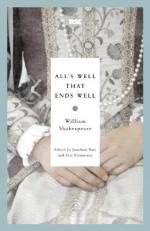|
This section contains 15,589 words (approx. 52 pages at 300 words per page) |

|
SOURCE: Parker, Patricia. “All's Well That Ends Well: Increase and Multiply.” In Creative Imitation: New Essays on Renaissance Literature in Honor of Thomas M. Greene, edited by David Quint, Margaret W. Ferguson, G. W. Pigman III, and Wayne A. Rebhorn, pp. 355-90. Binghamton, N.Y.: Medieval and Renaissance Texts and Studies, 1992.
In the following essay, Parker suggests linkages between characters, scenes, and themes in All's Well That Ends Well, arguing that the sexual terms “increase” and “dilation” have economic, verbal, hermeneutic, and familial implications in the play.
All's well that ends well! still the fine's the crown; Whate'er the course, the end is the renown.
(IV.iv.35-36)
In act II of All's Well That Ends Well, Parolles (the Shakespearean character whose name means “words”) advises the curter Bertram to employ more words in his “adieu” to the lords of the French court by taking what he calls...
|
This section contains 15,589 words (approx. 52 pages at 300 words per page) |

|


